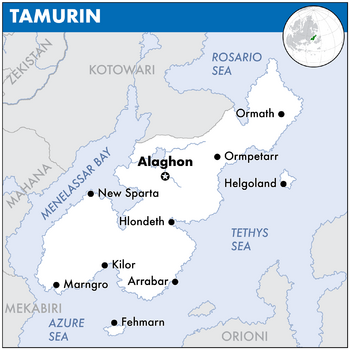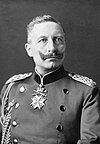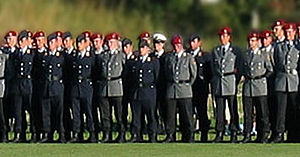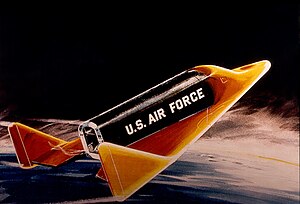Tamurin: Difference between revisions
m (→19th Century: Align images) |
m (→21st Century) |
||
| Line 166: | Line 166: | ||
[[File:Geloebnis SKB.jpg|thumb|Protecting Tamurin against Imperial Forces]] | [[File:Geloebnis SKB.jpg|thumb|Protecting Tamurin against Imperial Forces]] | ||
{{wp|Civil war}} erupted once more in 2004 when the far-right Imperialists regrouped after remaining in hiding for many decades. For three months it was not clear what will happen and who will win. It was a brief affair as nations from around the [[Orient]] rushed to the Republican banner. | {{wp|Civil war}} erupted once more in 2004 when the far-right Imperialists regrouped after remaining in hiding for many decades. For three months it was not clear what will happen and who will win. It was a brief affair as nations from around the [[Orient]] rushed to the Republican banner. | ||
With the help of [[Ekainak]], [[Byzantium Nova]], [[Orioni]] and several others, the Republic survived. With their help, the Republic survived. Its former president, William Granger, died, but his successor, President Hartman, led the Republic to victory. President Hartman, an independent politician and former mayor of Alaghon, is still serving as President in his first term. Another important citizen of Tamurin is Field Marshall von Steinburg, Chief of Staff of the Military. He fought bravely during the Second Civil War. His great ancestor, General von Steinburg, led the Republican forces during the First Civil War. Since the second civil conflict, Tamurin instituted a policy of 'Armed Neutrality' but despite this designation, the Republic does try to maintain as close ties as possible between the Oriental nations in Eastern Europa. | With the help of [[Ekainak]], [[Byzantium Nova]], [[Orioni]] and several others, the Republic survived. With their help, the Republic survived. Its former president, [[William Granger]], died, but his successor, President Hartman, led the Republic to victory. President Hartman, an independent politician and former mayor of Alaghon, is still serving as President in his first term. Another important citizen of Tamurin is [[Field Marshall von Steinburg]], Chief of Staff of the Military. He fought bravely during the Second Civil War. His great ancestor, [[General von Steinburg]], led the Republican forces during the First Civil War. Since the second civil conflict, Tamurin instituted a policy of 'Armed Neutrality' but despite this designation, the Republic does try to maintain as close ties as possible between the Oriental nations in Eastern [[Europa]]. | ||
Until July 31st 2005, a great coalition of conservatives and socialists was dominating the parliament. The new Vice-President, Martin Sumner, was a member of the isolationist movement which tried to reduce ties to the international community. The continued growth of the movement made day-to-day politics very difficult. On July 31st, 2005, the parliament which was dissolved earlier that month by President Hartman, was re-elected. Former Vice-President Sumner (who was fired) led the new isolationist movement and made it the strongest party. But he failed to achieve the absolute majority and a possible coalition with the nationalists failed. President Hartman is now working with a minority-alliance in the parliament. Shortly after that, President Hartman died due to a heart attack. In the following election, Martin Sumner was elected President. The isolationists formed an alliance with the socialists and were controlling the office of the president and the parliament. Tamurin cooled down its relations to other nations. | Until July 31st 2005, a great coalition of conservatives and socialists was dominating the parliament. The new Vice-President, [[Martin Sumner]], was a member of the isolationist movement which tried to reduce ties to the international community. The continued growth of the movement made day-to-day politics very difficult. On July 31st, 2005, the parliament which was dissolved earlier that month by President Hartman, was re-elected. Former Vice-President Sumner (who was fired) led the new isolationist movement and made it the strongest party. But he failed to achieve the absolute majority and a possible coalition with the nationalists failed. President Hartman is now working with a minority-alliance in the parliament. Shortly after that, President Hartman died due to a heart attack. In the following election, Martin Sumner was elected President. The isolationists formed an alliance with the socialists and were controlling the office of the president and the parliament. Tamurin cooled down its relations to other nations. | ||
Nearly a year after that the isolanist government broke down when the party fell apart. The isolationist movement had never too much common ground and after Tamurin lived for itself conflicts broke out. After Martin Sumner resigned in March 2006, Chief of Staff and Minister of Defense Field Marshall von Steinburg took over the government, dissolved the Parliament and set up a provisional government until re-elections were held on June 1st. In these elections a progressive alliance consisting of Progessive Conservatives, Social-Democrats and Socialists won the elections, with the Social-Democrats taking over the presidency (Jürgen Axmann), the Progressive Conservatives taking over the Prime Ministry (Hermann Leonhardt) and daughter of former President Hartman Claudia Hartman becoming "Super Minister" for Defense, Foreign Relations and Technology. | Nearly a year after that the isolanist government broke down when the party fell apart. The isolationist movement had never too much common ground and after Tamurin lived for itself conflicts broke out. After Martin Sumner resigned in March 2006, {{wp|Chief of Staff}} and {{wp|Minister of Defense}} [[Field Marshall von Steinburg]] took over the government, dissolved the Parliament and set up a provisional government until re-elections were held on June 1st. In these elections a progressive alliance consisting of {{wp|Progessive Conservatives}}, {{wp|Social-Democrats}} and {{wp|Socialists}} won the elections, with the Social-Democrats taking over the presidency (Jürgen Axmann), the Progressive Conservatives taking over the Prime Ministry ([[Hermann Leonhardt]]) and daughter of former President Hartman [[Claudia Hartman]] becoming "Super Minister" for Defense, Foreign Relations and Technology. | ||
During the Conference for Security and Cooperation in Europa (CSCE) a group of terrorists linked to the | During the [[Conference for Security and Cooperation in Europa]] (CSCE) a group of terrorists linked to the [[Imperial North-East Liberation Front]] (INELF) seized control of the CSCE-building and killed several delegation members including President Axmann. Minister Hartman was able to escape. After a terrible rescue operation in which nerve gas was used (which killed terrorists, security guards and hostages), the Tamurinian security forces were able to re-take the building, although several mistakes were done during the mission (e.g. friendly fire on hostages). The whole conference was a political desaster for the tamurinian government. Wolfgang Leonhardt became President, Claudia Hartman prime minister. Currently the INELF is gaining strength in North-East Tamurin (Ormath) and civilian groups are putting up pressure on the government because of its obvious lack of skill. | ||
In 2006, Tamurin became a founding member of the [[Entente of Oriental States]]. | In 2006, Tamurin became a founding member of the [[Entente of Oriental States]]. | ||
Revision as of 09:30, 12 June 2020
The Republic of Tamurin | |
|---|---|
 Map of Tamurin | |
| Capital | Alaghon |
| Demonym(s) | Tamurine |
| Government | Presidential democracy |
• President | Jurgen Brosch |
• Prime Minister | Otto Krüger |
| Legislature | Parliament |
| Population | |
• 2019 census | 80,193,963 |
| Currency | Tamurine Credit (TRC) |
| Time zone | UTC +9 |
| Driving side | right |
| Calling code | +74 |
| Internet TLD | .tm |
The United Republic of Tamurin is a medium-, sovereign nation located on the continent of Europa, located on a peninsula, across from Orioni. The Tamurine people were long divided until they were unified in 1871 under the Emperors. Since 1913, Tamurin has been a democracy led by a President, managed by a Prime Minister, and governed by a bicameral parliament. It is a major economic power in Eastern Europa.
Geography
Tamurin lies on a large peninsula. It has only one land border with the Republic of Rekamgil. The landscape is dominated by hills and scattered forests. The nation has an oceanic Mediterranean climate. Most people reside in the countryside but the major cities are Alaghon, Arrabar, Hlondeth, Ormath, Ormpetarr, and Nimpeth. Tamurin has only one short land border in the north, but a very long coastline.
Tamurin consists of three regions: Tamurin in the centre, Ormpetarr in the south and Ormath in the north. Ormath was the former capital of Imperial Tamurin. Tamurin has also two island departments, Helgoland (north) and Fehmarn (south).[1]
The area was known as Menelassar Bay offers some of the best surfing on Eurth. Before the bay earned international renown, locals refused to share their favourite beaches because they didn't want outsiders to discover their wealth of surfable seas. Dolphins are often found close to shore. Each morning both Spinners and Bottlenose dolphins can be found playing close to shore before heading back to the open water. Multiple boat companies offer tours to see and swim with dolphins.
The coastline's hot and dry environment presents excellent conditions for salt making. The salt pans cover a large area along the coast and can be seen from space. Salt production dates back to the Orinese period and remained largely unchanged. Water is pumped directly from the nearby sea and allowed to evaporate in the basins. The salt is collected a few days later. Tamurine salt is exported to many other nations.
History
Ancient history
Medieval period
Early modern period
19th Century
The Empire of Tamurin, ruled by the League of the Lords, was founded in 1871 after several centuries of division. Until 1871, Tamurin was a divided land of dozens of large and small territories, each ruled by their own leader. The Empire was brought into existence by the strongest of these lords, George Menelassar (...-1888), by way of force and politics. He founded the “League of the Lords”, which was mostly called “Imperial League”. The League was the upper house of the parliament, while the lower house was democratically elected. Actions of the lower house could be overruled by the upper house, which happened very often. One of his first acts was the establishment of the Tamurin Parliament with the lords in the upper chamber while the lower house was democratically elected. The parliamentarians of the lower house overruled the nobility quite often. Emperor Menelassar I died in 1888. His rule was regarded as harsh, but he had completely transformed Tamurin into a powerful, militaristic state.
His son, James Menelassar II ($year-$year), succeeded him. He was far more liberal and had great respect for the elected lower chamber of parliament, especially the republican party. To further improve relations, the Emperor introduced the position of Prime Minister who would take on centralized responsibility for leading the Government. Prior to the role, the Emperor had done that himself. This transferred foreign policy and control of the armed forces to his Prime Minister. Though Menelassar II was loved by the people, he was not by the nobles and was forced to resign in 1896 when the nobility and the Emperor got into a nasty political battle over the furtherance of democratic improvements sought by the lower chamber.
His hardliner brother, Jacob Menelassar III ($year-$year), became Emperor after a one-month political standoff. Menelassar II. left the the upper house and joined the republican party. He became a great leader of them, while his brother tried to undo the democratic changes. He used methods of totalitarian systems which caused widespread opposition, even in the ranks of the Lords and the armed forces.
20th Century
It was around the turn of the century where a wave of reactionary and totalitarian regimes existed. In response to his brother's complete reversal of both his and their grandfather's work, he withdrew from the House of Lords and ran for a seat in the democratically elected lower chamber, which greatly enhanced his reputation. At first, the nobles approved of Menelassar III's ways but once he took action against the armed forces and the ranks of the aristocracy who disagreed with him, a civil war was inevitable. The bloody First Tamurin Civil War lasted from 1903-1911 and resulted in the collapse of the Empire of Tamurin and the creation of the Republic.
From 1911-2004, the Republic of Tamurin was a more or less stable nation. The initial years of the Republic, between 1912 and 1937, various social democratic parties governed the nation and tried to establish a system around the socialist idea of philosopher Markus Karlaz. These attempts failed and the results were devastating. The economy was down, and the country was taken backwards technologically. The people were very dissatisfied. Centrist governments took hold and modernized into a top-level economic powerhouse from 1938 to 1967. The liberal-conservative government brought the nation back to the first of Europa.
In 1968 there was a student revolt. The liberal-conservative government was still in the 30s (with its mind). The more centre-right Progressive took charge.
21st Century
Civil war erupted once more in 2004 when the far-right Imperialists regrouped after remaining in hiding for many decades. For three months it was not clear what will happen and who will win. It was a brief affair as nations from around the Orient rushed to the Republican banner. With the help of Ekainak, Byzantium Nova, Orioni and several others, the Republic survived. With their help, the Republic survived. Its former president, William Granger, died, but his successor, President Hartman, led the Republic to victory. President Hartman, an independent politician and former mayor of Alaghon, is still serving as President in his first term. Another important citizen of Tamurin is Field Marshall von Steinburg, Chief of Staff of the Military. He fought bravely during the Second Civil War. His great ancestor, General von Steinburg, led the Republican forces during the First Civil War. Since the second civil conflict, Tamurin instituted a policy of 'Armed Neutrality' but despite this designation, the Republic does try to maintain as close ties as possible between the Oriental nations in Eastern Europa.
Until July 31st 2005, a great coalition of conservatives and socialists was dominating the parliament. The new Vice-President, Martin Sumner, was a member of the isolationist movement which tried to reduce ties to the international community. The continued growth of the movement made day-to-day politics very difficult. On July 31st, 2005, the parliament which was dissolved earlier that month by President Hartman, was re-elected. Former Vice-President Sumner (who was fired) led the new isolationist movement and made it the strongest party. But he failed to achieve the absolute majority and a possible coalition with the nationalists failed. President Hartman is now working with a minority-alliance in the parliament. Shortly after that, President Hartman died due to a heart attack. In the following election, Martin Sumner was elected President. The isolationists formed an alliance with the socialists and were controlling the office of the president and the parliament. Tamurin cooled down its relations to other nations.
Nearly a year after that the isolanist government broke down when the party fell apart. The isolationist movement had never too much common ground and after Tamurin lived for itself conflicts broke out. After Martin Sumner resigned in March 2006, Chief of Staff and Minister of Defense Field Marshall von Steinburg took over the government, dissolved the Parliament and set up a provisional government until re-elections were held on June 1st. In these elections a progressive alliance consisting of Progessive Conservatives, Social-Democrats and Socialists won the elections, with the Social-Democrats taking over the presidency (Jürgen Axmann), the Progressive Conservatives taking over the Prime Ministry (Hermann Leonhardt) and daughter of former President Hartman Claudia Hartman becoming "Super Minister" for Defense, Foreign Relations and Technology.
During the Conference for Security and Cooperation in Europa (CSCE) a group of terrorists linked to the Imperial North-East Liberation Front (INELF) seized control of the CSCE-building and killed several delegation members including President Axmann. Minister Hartman was able to escape. After a terrible rescue operation in which nerve gas was used (which killed terrorists, security guards and hostages), the Tamurinian security forces were able to re-take the building, although several mistakes were done during the mission (e.g. friendly fire on hostages). The whole conference was a political desaster for the tamurinian government. Wolfgang Leonhardt became President, Claudia Hartman prime minister. Currently the INELF is gaining strength in North-East Tamurin (Ormath) and civilian groups are putting up pressure on the government because of its obvious lack of skill.
In 2006, Tamurin became a founding member of the Entente of Oriental States.
Politics
The nation has a presidential democracy, meaning that the President and the Parliament are both directly elected by the people. Tamurin is decentralized and several local parliaments are dealing with local issues. The national parliament is only concerned with national issues.
Executive branch
The President is the head of state who holds certain defined responsibilities concerning the government. The Presidency is currently held by Jurgen Brosch, a social democrat. It is the Prime Minister, who is traditionally the leader of the largest party in Parliament who is tasked with day-to-day affairs of state. Otto Krüger, chair of the Progressive Party (which is not as 'left-leaning' as others on Eurth), has maintained the position for the past three elections. Both men are Orientalists who prefer to maintain and further ties with the local region.
- The President. Jürgen Axmann: 55 years old, member of the social-democrats. He is neither Orientalist nor Continentalist and would like to be Tamurin the "gateway" for the continent to reach the Orient and vice-versa. Internal, he is a left-leaning liberal, trusting in the free market, but trying to secure it with social policies and extensive welfare programs.
- The Prime Minister. Hermann Leonhardt: 51 years old, member of the progressive party. He is an "Orientalist", meaning that his political agenda is the oriental coastal region. He prefers ties to the regional nations and wishes to establish a political union of the eastern coast. In terms of internal politics he stands between liberals and conservatives. His agenda is a "conservatism with heart".
Legislative branch
Parliament is empowered to legislate and to tax. It has 210 members and coalitions are tight with little space for compromise across sides. The Socialist, Progressive, Conservatives, and Liberals make up the majority of the seats, with a small number possessed by the Greens and far-right isolationist party. There is an independent judiciary.
Parties
The parties:
- The Traditional party ("old conservatives"): Right-wing party, democrats, free market, "party of the rich"
- The Progressive party ("new conservatives"): Right-Center-party, democrats, free market, "party of the middle people"
- The Liberals: Center party, democrats, extreme free market, "party of the economy"
- The social-democrats Center-Left-party, democrats, reduced free market, "party of the small people"
- The socialists: Left party, democrats and soviet democrats, no free market, self-proclaimed worker's party
- The Union of the North: Far right-wing, anti-democrats, free market, old imperialists and fascists
- The Greens: Center, democrats, ecologial free market, "nature party"
Military
The Republic has an Army, Navy, and Air Force (Luftwaffe). They have a small elite special force detachment that sees more action than the other branches. Tamurin has an armed neutrality policy but that hasn't completely prevented Tamurin from involvement in military activities with the Entente of Oriental States as long as those missions are within the general region. Despite its population, the total number of active personnel is merely 185,000.
Economy
Culture
References
- ↑ Tamurin, Goobergunch wiki (captured 3 May 2008)
External links
Work in progress
- Integrate details from the Turin history.
- Integrate analogues from the Tamils people.
- Establish links with the history of Orioni.






